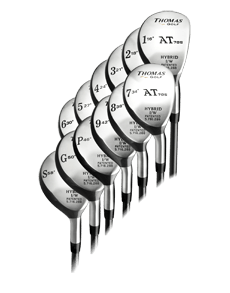
One of the key factors in a golfer's success is the ability to consistently hit the sweet spot on their clubs. The sweet spot is the area on the clubface that allows for maximum distance and control when struck correctly. However, not every shot is perfect, and mishits can happen. In these instances, having a fairway wood with a larger sweet spot can indeed improve forgiveness.
What is the Sweet Spot?
The sweet spot on a fairway wood is the spot on the clubface that delivers the best combination of energy transfer and feel. When the ball is struck on the sweet spot, it results in a clean and solid hit, maximizing distance and accuracy. Striking the ball off-center results in mishits, which often lead to less distance, accuracy, and control.
The Importance of Forgiveness
Forgiveness in golf refers to the club's ability to minimize the negative effects of mishits. When a golfer strikes a fairway wood off-center, the larger sweet spot helps to maintain more of the ball's initial energy and redirect it towards the intended target. This improved forgiveness reduces the loss of distance and control associated with mishits.
The Role of a Larger Sweet Spot
A fairway wood with a larger sweet spot allows for a greater area of the clubface to deliver efficient energy transfer. When the golfer strikes the ball anywhere within this larger sweet spot, they can expect a more forgiving shot. This means that even if a golfer slightly misses the center of the clubface, the larger sweet spot can still produce solid results.
Benefits of Improved Forgiveness
A larger sweet spot and improved forgiveness offer several benefits to golfers:
- Consistency: A larger sweet spot allows golfers to achieve more consistent results, even on mishits. This consistency helps to build confidence in a player's game.
- Distance: Mishits typically result in a loss of distance. With improved forgiveness, golfers can expect better distance control, even on shots that are not struck perfectly.
- Accuracy: By reducing the negative effects of mishits, a larger sweet spot helps golfers maintain better control over the direction of their shots. This improved accuracy can lead to lower scores.
- Enjoyment: Golf is a game that is often fueled by moments of success. When golfers experience more forgiving shots, they are likely to enjoy the game more and feel encouraged to continue improving.
Conclusion
A fairway wood with a larger sweet spot can undoubtedly improve forgiveness on mishits. The larger sweet spot provides golfers with a greater opportunity to achieve consistent results, maintain distance control, improve accuracy, and enhance their overall enjoyment of the game. When selecting a fairway wood, it is essential to consider the size and design of the sweet spot to maximize forgiveness and optimize performance on the golf course.
Update:
Can a fairway wood with a larger sweet spot improve forgiveness on mishits?
Yes, a fairway wood with a larger sweet spot can improve forgiveness on mishits. Here's how:
- Reduced Distance Loss: A larger sweet spot provides more area on the clubface where maximum ball speed is achieved. When you hit the ball slightly off-center, such as toward the toe or heel, a larger sweet spot helps maintain higher ball speeds and reduces the distance loss compared to smaller sweet spots.
- Improved Accuracy: Mishits tend to result in shots that fly offline. With a larger sweet spot, off-center hits are less likely to veer drastically off course. This improved accuracy means that shots hit slightly toward the toe or heel are more likely to stay closer to your intended target line.
- Consistent Trajectory: Mishits with a smaller sweet spot can lead to inconsistent ball flights, including low hooks or high slices. A larger sweet spot helps stabilize the clubhead at impact, promoting a more consistent trajectory even on mishits, resulting in shots that fly straighter and with more predictable distances.
- Enhanced Confidence: Knowing that your fairway wood has a larger sweet spot can instill confidence in your swing. This confidence allows you to make smoother, more relaxed swings, which in turn helps reduce the frequency of mishits.
- Reduced Side Spin: Mishits with a smaller sweet spot tend to generate more side spin, leading to shots that curve off line. A larger sweet spot minimizes the amount of side spin produced on mishits, resulting in straighter, more accurate shots.
Q&A On Can a fairway wood with a larger sweet spot improve forgiveness on mishits?
- Q: What is a sweet spot on a golf club?
- A: The sweet spot refers to the center area of the clubface where maximum energy transfer occurs between the club and the ball, resulting in optimal distance and accuracy.
- Q: How does a larger sweet spot benefit golfers?
- A: A larger sweet spot provides more forgiveness on mishits by maintaining higher ball speeds and reducing distance loss on off-center strikes.
- Q: Can a larger sweet spot completely eliminate mishits?
- A: While a larger sweet spot significantly reduces the negative effects of mishits, it cannot entirely eliminate them. However, it does help minimize the distance and accuracy penalties associated with off-center strikes.
- Q: Are there any drawbacks to using a fairway wood with a larger sweet spot?
- A: There are generally no significant drawbacks to using a fairway wood with a larger sweet spot. However, some golfers may prefer the feel or workability of clubs with smaller sweet spots.
- Q: How can I determine if a fairway wood has a larger sweet spot?
- A: Golf club manufacturers often provide information about the size and location of the sweet spot in product specifications. Additionally, club reviews and fitting sessions can offer insights into a club's forgiveness and sweet spot characteristics.
- Q: Can adjusting the weight configuration of a fairway wood affect its sweet spot size?
- A: While adjusting the weight configuration of a fairway wood can impact its forgiveness and playability, it typically does not directly affect the size of the sweet spot.
- Q: Can using a fairway wood with a larger sweet spot improve my accuracy on approach shots?
- A: Yes, a fairway wood with a larger sweet spot can improve accuracy on approach shots by reducing the negative effects of mishits and promoting more consistent ball flights.
- Q: Should I prioritize sweet spot size when choosing a fairway wood for forgiveness?
- A: Sweet spot size is an essential factor to consider, but it should be balanced with other factors such as feel, trajectory, and shot shape preferences. A larger sweet spot can certainly enhance forgiveness, but it's essential to find the right combination of features that suit your game and preferences.
In golf, a fairway wood with a larger sweet spot can significantly improve forgiveness on mishits. Here's why:
Sweet Spot and Forgiveness:
-
The sweet spot is the area on the clubface where a struck ball achieves optimal distance and accuracy. Mishits, or impacts made away from the sweet spot, result in reduced ball speed, distance loss, and a trajectory that deviates from your desired flight path.
-
Forgiveness refers to a club's ability to minimize the negative effects of mishits. A club with a larger sweet spot offers a bigger margin for error, meaning even if you don't strike the ball perfectly, the performance won't suffer as drastically.
How Larger Fairway Woods Achieve Forgiveness:
-
Increased MOI (Moment of Inertia): Larger clubheads typically have a higher MOI. MOI is a measure of a club's resistance to twisting at impact. A higher MOI translates to less clubface twist on mishits, leading to straighter ball flight and more consistent results.
-
More Material: A larger clubhead allows for the distribution of weight further away from the center, which again increases MOI and promotes straighter ball flight on off-center hits.
Benefits of Forgiveness:
- Improved Accuracy: Mishits are less likely to cause drastic hooks or slices, keeping your ball in play more often.
- More Consistent Distance: Even on off-center strikes, the larger sweet spot helps maintain a more predictable distance compared to a smaller sweet spot club.
- Confidence Boost: Knowing you have a more forgiving club can boost your confidence when addressing the ball, potentially leading to a smoother swing and better overall performance.
Who Can Benefit Most?
- High handicappers and beginners: Golfers who are still developing consistent swing mechanics benefit greatly from the forgiveness offered by larger sweet spot fairway woods.
- Average golfers: Even mid-handicappers can experience more consistent performance and improved accuracy with a forgiving fairway wood.
- Golfers who struggle with mishits: If you find yourself hitting off-center frequently, a larger sweet spot can significantly improve your game.
Drawbacks of Larger Fairway Woods:
- Potentially bulkier feel: Some golfers might find larger clubheads to be a bit bulky and prefer the sleeker look of smaller fairway woods.
- Slight weight difference: Larger heads can be marginally heavier, but modern club design often mitigates this difference.
Overall:
While there might be a slight trade-off in feel or weight, the forgiveness benefits offered by a larger sweet spot fairway wood are significant. This makes them a great option for a wider range of golfers, especially those seeking to improve accuracy and consistency in their fairway game.






